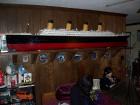One of the many theories going round with Titanic after it sank is the rivet theory, that excessive slag, a by product when producing the rivets, caused the rivet to be substandard to rivets with normal levels of slag. Her latest podcast could be found at http://www.johnshopkins.edu/podcasts/Mysteries_of_History_Jennifer_McCarty.html
Jennifer Hooper McCarty has taken on this theory in her dissertation, recommended by her thesis supervisor, Dr. Tim Foecke at the National Institute of Standards & Technology (NIST). Jennifer Hooper McCarty graduated at John Hopkins and is currently a licensing associate with them.
McCarty joined the staff of OHSU's Office of Technology & Research Collaborations in October 2005 where she negotiates sponsored research agreements, material transfer agreements, and the licensing of university discoveries to the commercial sector.
Prior to coming to OHSU, McCarty was a guest researcher and consultant at NIST, post-doctoral researcher at the University of Oxford where she did metallography analyses of 18th-20th century rail materials from the National Railway Museum in York (UK) and Roman coin deposits, and a research scientist at the Smithsonian Institution's Center for Materials Research and Education.
Besides her Ph.D. from Johns Hopkins, she holds an M.S.E. degree in materials science and engineering from that institution and a B.S. in chemistry from Temple University.
Dr Tim Foecke currently works at (NIST) as a Material Scientist in MD. He has shown interest in Fracture micromechanisms, Nanomaterial mechanical properties,
Electron microscopy, Metal forming, Historical metallurgy. His personal website can be visited at
http://www.metallurgy.nist.gov/webpages/TFoecke/
The existing “rivet theory†was further developed by McCarty and Foecke, They tested 48 rivets and found that slag levels were as high as 9 percent while concentrations of 2-3 percent strengthen the steel, higher percentages will weaken the steel they said.
Stress testing showed that the substandard rivets popped at half the weight (9,000 pounds or 4,000 kg) when compared to rivets with normal slag levels.
The rivets on Titanic failed to sustain stresses due to the collision with the iceberg, which led them to pop faster than expected. This resulted in large pieces of steel orginially held together by the same rivets to deattach from each other and creating gaps large enough for water to breach too many water tight compartments.
Internet links:
Audio:
{OHSU researcher unlocks Titanic mystery, The Oregonian}
http://www.blogs.oregonlive.com/uploads/238203-titanic.mp3
{Mysteries of History 1 : Why did the Titantic really sink so fast?, Jennifer Hooper McCarty }
http://www.johnshopkins.edu/podcasts/Mysteries_of_History_Jennifer_McCarty.mp3
News:
{Scientist helps fathom Titanic's fatal weakness 21 October 2006}
http://www.oregonlive.com/news/oregonian/index.ssf?/base/news/1161401138231030.xml&coll=7
| ||||
|
|
Main Menu
Recent News
Latest Articles
Random photos
|
Titanic exploration : McCarty: Rivets contained excessive slag
The comments are owned by the poster. We aren't responsible for their content.
|
Recent Photos
|
|












































